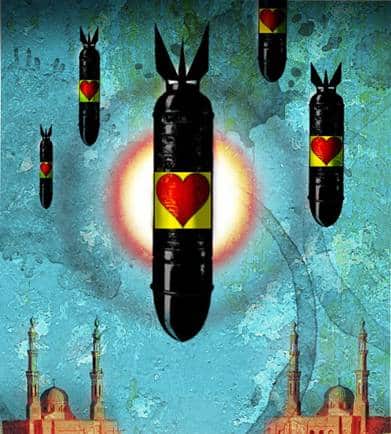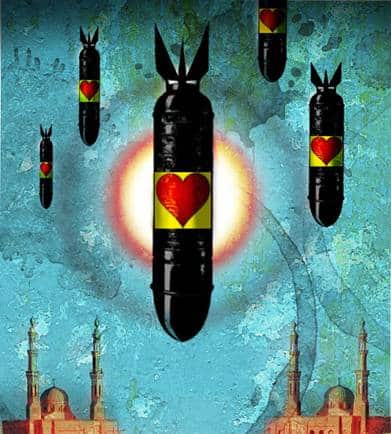Two seemingly unrelated stories in the New York Times yesterday serve as potent reminders of the deadly and disastrous consequences of US interventionism in the Middle East. The stories involve Iran and Libya.
Referring to Donald Trump’s campaign vow to tear up the nuclear agreement entered into last year between the United States and Iran, Iran’s president, Hassan Rouhani, told an audience at Tehran University, “America cannot influence our determination, this nation’s resistance and its struggle. America is our enemy; we have no doubt about this. The Americans want to put as much pressure on us as they can.” During the talk, the student audience chanted, “Death to America.”
Rouhani is especially chagrined at what he perceives to be a double cross by US officials, who have continued their regime of brutal sanctions against Iran notwithstanding Iran’s signing of the nuclear agreement.
What’s important to realize, however, is that the bad relations between the United States and Iran are rooted in US interventionism, specifically the CIA’s violent coup in 1953, which succeeded in destroying Iran’s experiment with democracy.
The Iranian parliament had elected a prime minister named Mohammad Mossadegh, who was later selected as Time magazine’s Man of the Year. Mossadegh, believing that Iran’s oil belonged to the Iranian people and not to British or other foreign firms, proceeded to nationalize the country’s oil industry. British officials prevailed on the CIA to oust Mossadegh in a coup, which the CIA proceeded to do, replacing him with the Shah of Iran, who then restored British oil rights.
In order to fortify the Shah’s hold on power, the CIA proceeded to train his secret national police-intelligence force in the arts of indefinite detention, torture, and surveillance. Under the tutelage and with the full support of the CIA, the Shah’s regime, which was always unelected, became one of the most tyrannical regimes in the world.
That’s what brought about the 1979 Iranian revolution. That’s what people who are suffering under extreme tyranny sometimes do — they revolt, violently. Needless to say, many Iranians were angry not just at the Shah, but also by his enabler and supporter, the US government.
Unfortunately, the Iranian people were unable to restore the democratic system that the CIA had destroyed 20 years before. The result of the 1979 revolution was another tyrannical regime, one based on religion.
Relations between Iran and the United States have been horrible ever since. What is important to recognize is that those bad relations are rooted in the 1953 intervention and that it is the US government that is ultimately responsible for what its coup ended up bringing in Iran.
The other New York Times article was about Libya. It stated that Libyan fighters are celebrating their recent victory over the Islamic State in Libya, following, of course, lots of fierce fighting and after much death and destruction.
According to the article, “Analysts warned that the Islamic State could still regroup in other parts of Libya by exploiting the economic ruin and political vacuum that has dogged the country since the ouster of Col. Muammar el-Qaddafi in 2011.”
In the interests of accuracy, that sentence should have stated more specifically, “….since the US government’s ouster of Col. Muammar el-Qaddafi in 2011.”
Like Mossadegh, Qaddafi was made a target of a US regime-change operation, one designed to replace him with a US-approved ruler. But like with the Iranian intervention, things didn’t turn out as planned. Instead, Libya was thrown into a violent and vicious civil war involving multiple factions, including the Islamic State.
And it’s not like the US national-security establishment was unaware that a violent regime change operation can result in a civil war. In 1954, the CIA, in a violent military operation, ousted the democratically elected president of Guatemala, replacing him with a brutal, unelected military dictatorship whose tyrannical regime would be very similar to that of the Shah’s. That regime-change operation threw the country into a violent civil war that lasted some 30 years and resulted in the deaths of more than a million people.
And let’s not forget why the Islamic State exists. It exists as a direct result of the US regime-change operation in Iraq in 2003 — the one in which US officials used bogus WMD scares to garner support for what was really an illegal and unconstitutional war of aggression against a country that had never attacked the United States.
Among the ironies of the Iraq regime-change operation was the fact that in the 1980s the US government had partnered with Iraq’s leader, Saddam Hussein, in his war of aggression against Iran.
Why did the US government help Saddam kill Iranians?
That question returns us to the first part of this article. It was because the Iranian people had ousted the CIA’s man in Iran, the Shah, from power, which angered US officials. To retaliate against the Iranian people, US officials decided to help Saddam Hussein in his quest to kill Iranians as part of his war of aggression against Iran.
Let’s also not forget other consequences of US interventionism in the Middle East — the ongoing threat of terrorist retaliation, which has generated the so-called war on terrorism and the anti-Muslim crusade, along with the destruction of American liberty and privacy at the hands of the national-security establishment. Also worth mentioning is the massive refugee crisis in Europe, which almost certainly would never would have occurred but for US interventionism in the Middle East.
Question: Why would any American continue to support US foreign interventionism, including interventionism that purports to fix the problems of previous interventions?
Reprinted with permission from the Future of Freedom Foundation.


